How To Send Better Weekly Newsletters And Drive Recurring Traffic To Your Site
Do you struggle to drive recurring traffic to your site from your newsletter?
In this guide, we’re going to show you a few simple changes you can apply to your newsletter to make it more engaging.
For clarification, when we say “newsletter,” we’re referring to the weekly email you send to your audience wrapping up the posts you’ve published in the last week. This is not a guide on how to structure every email you send to your audience.
With that said, let’s start with your email marketing platform.
How to choose the best email marketing platform for your needs
For the purposes of this post, we’re going to use Drip as an example because it offers a great balance between functionality and ease of use.
It has advanced marketing automation that is simpler to use than other platforms. This can be used to segment your email list, and deliver more relevant offers to your subscribers.
And it has a nice drag-and-drop visual builder to customize your email newsletters to fit your branding.
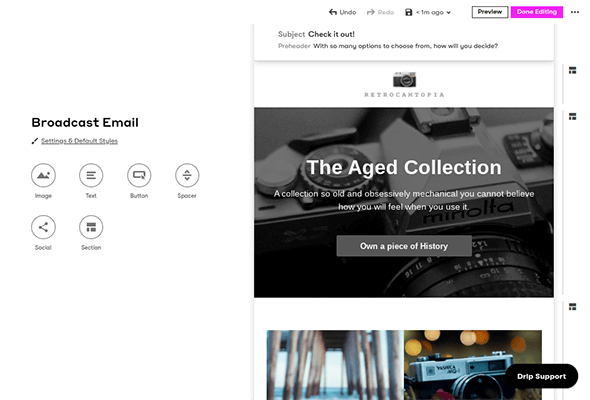
The platform also has a few fully designed templates to choose from. You can even build your own templates and save them for later use.
Drip has a 14-day free trial, after which plans start at $19/month for up to 500 subscribers.
It is worth mentioning that there may be other email providers that are a better fit for your needs. We have a dedicated article on email marketing providers, if you’d like to have a read.
Determine what information you want to share in your newsletter
Once you’re all set up with your preferred email marketing platform, you can get to work on planning your weekly newsletter.
There are many types of content you can add to your newsletter, but because we’re focusing on getting traffic to your site, we’ll focus primarily on content published on your site.
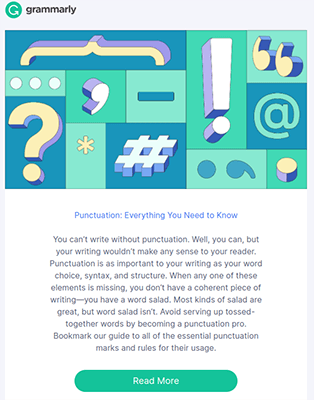
These include your latest blog posts, videos and podcast episodes. Hopefully, you’re creating new posts for your videos and podcasts alongside transcripts and show notes for each.
The transcripts are great for SEO, but more importantly, you’ll be able to drive traffic for your video and podcast content directly to your site rather than a third-party platform where distractions exist.
Product updates are another great addition as they provide a fantastic opportunity to include a call to action for a free trial or discount. This is where segmentation comes in handy as you can send a different version of your newsletter that uses a different call to action for subscribers who have already purchased that product.
A few additional pieces of content you can share from your site include announcements, your favorite comment you received that week, hot threads of the week if you run a forum, and a collage of images if you take or create your own images.
While your primary goal for your newsletter should be to drive more recurring traffic to your own site, you may want to also include other forms of content, even if they aren’t your own.
It may seem counterproductive to include links to external sites in your emails, but it can actually improve your retention rate as subscribers will likely enjoy being able to receive updates for your niche from one source.
Examples of these content types include:
- Industry news
- Top articles from your competitors
- Updates from products you recommend
- Hot tip of the week
- Relevant quotes
Once you decide what types of content you want to include in your newsletter, you’re ready to move on to the next step.
How to structure your email newsletter
Many of Drip’s default templates will work just fine for newsletters, especially the Big Beautiful Images template, but you can just as easily start from scratch or use a blank template and build your own designs.
The most important aspect of a weekly newsletter is consistency. Readers love consistency, and it’s a great way to make your brand recognizable. Whatever layout and design you choose today, you’ll want to save it as a template so you can use it again next week and the week after that.
Let’s start with promoting your latest posts, videos and podcast episodes since those are the main content types that will drive traffic to your site. Plain-text emails are effective for welcome email series, ecommerce emails and autoresponders, but you’ll want to use a more stylized approach for your weekly newsletter.
This is due to the very nature of the weekly newsletter. It’s designed to promote a variety of different things at once, and you need a way to draw attention to the things you want your audience to pay attention to the most.
Our eyes are more drawn to images than text. Just check out these stats on visual marketing as proof:
- Blog posts with images receive 650% more engagement than posts with only text.
- Tweets with images are 150% more likely to be retweeted.
- Bloggers who utilize visual content grow 12x faster.
- 80% of individuals remember what they’ve seen versus only 10% who remember what they’ve read.
As such, you should promote your most important pieces of content of the week with click-worthy headlines, eye-catching images and clear calls to action. You can also include a brief description that grabs your reader’s attention but makes them want to click your call to action to learn more.
If you have a single piece of content you want to promote more than others week to week, add a hero section at the top of your email.
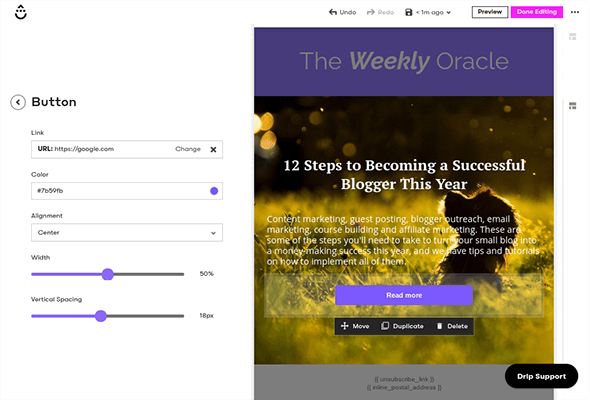
Use smaller column or grid-based layouts for the rest.
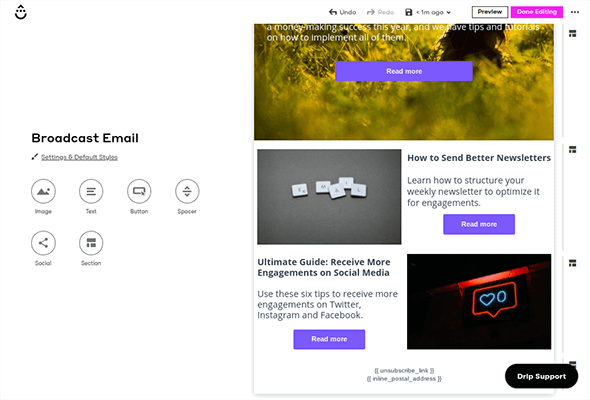
If you have video and podcast episodes to promote as well, use a different layout type to promote them than what you used to promote your blog posts.
For instance, if you use a grid-based layout like the one above to promote your blog posts, switch to a column layout to promote your latest podcast episode then back to a grid layout to showcase your videos.
Building the rest of your email
If you have a product or product update to promote, give it its own hero section to draw more attention to the announcement and its call to action.
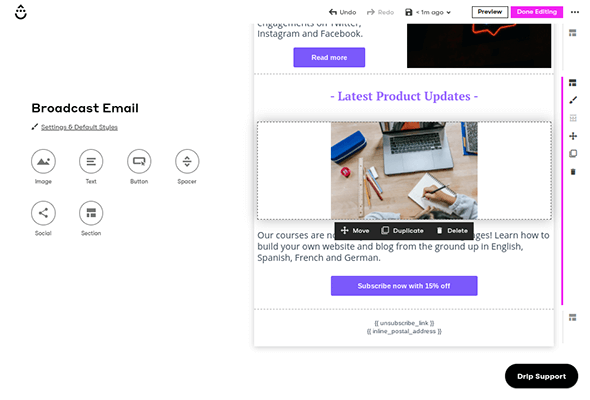
Play around with your email marketing platform’s email builder to come up with your own designs for top comments, forum threads and quotes. Just be sure any calls to action you use aren’t overshadowed by other elements.
However, if you want to include links for industry news and top articles from around your niche, use a design that won’t draw much attention to them.
Readers who are truly interested in this type of content will browse this section, anyway, so you may as well use a design that’s less engaging if you’re going to include it. This ensures your subscriber’s attention is drawn to the images and headings you apply to your own content.
For these types of links, plain text will suffice. You can even utilize bullet points if your platform’s email builder includes them.
Finalizing your newsletter
Once you’ve added all of the content you’d like to add, you’re ready to move on to the final steps of perfecting your newsletter: applying styles, writing a subject line and choosing when to send it.
Remember when we talked about branding and consistency? This applies to the styles you use for your newsletter as well. It’s best to choose styles that match your blog for this reason.
For instance, if your blog’s primary colors are specific HEX shades of green and black, use those for links, buttons and headers in your newsletter.
You should never use more than two fonts on a web page, and that rule works for newsletters as well. However, if your blog only uses a single font, your newsletter should only use that font as well.
Your readers are going to read your newsletter, then click on through to your blog. Having consistency in the styles you use will make your brand more memorable to them over time without them even realizing it.
If you’re using Drip or another platform that allows you to save your own templates, do so now to save yourself time next week.
Subject lines and send times
It’s perfectly fine to name and number your newsletters and showcase both inside. However, be more creative when it comes to naming your subject line. Don’t toss “The Weekly Oracle, #47” in there.
Remember, your audience has problems, and the best way to market yourself to them is to provide solutions to those problems. So, instead of “The Weekly Oracle, #47: 12 Steps to Becoming a Successful Blogger This Year,” write something along the lines of “Hey {personalize with first name}, blogger outreach is the best way to succeed in blogging this year. I’m not kidding”.
Note: If you need more help with subject lines, check out our guide to writing compelling email subject lines.
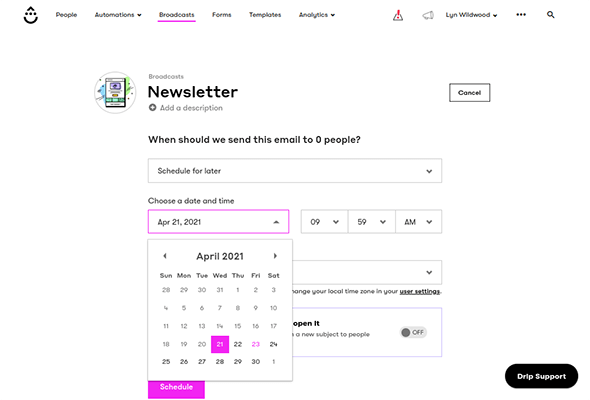
As for send times, you’re going to want to run some tests with your individual audience to determine the best time to send. However, consistency is important here, too, so once you find the best time, stick with it week to week.
Since this is a weekly newsletter wrapping up the events of the week, test Fridays, Saturdays and Sundays only. Spend a few weeks sending your newsletter on Friday mornings, then a few weeks on Friday afternoons and finally Friday evenings.
After you test Saturdays and Sundays as well, you should have a pretty clear indicator as to when your audience is most likely to read your newsletters.
Final thoughts
There are those that think email marketing is dead. The truth? It is still one of the most profitable marketing channels out there. You can check out our roundup of email marketing stats if you need proof.
And the weekly email newsletter isn’t dead either. You just need to tweak its content and styles to suit your needs and your audience’s preferences.
When you use attention-grabbing images, click-worthy headlines and clear calls to action, you’ll improve engagement and find yourself with a consistent flow of recurring traffic week to week.
If you want to engage your audience even more, apply segmentation to your newsletters. This will ensure you don’t promote discounts for products your customers have already purchased or that you don’t promote advanced guides to beginners.
Most importantly, no matter how you approach your newsletter, be consistent week to week so your audience gets used to seeing you in their inboxes.
Related Reading:
- The No-Fail Guide To Attracting More Traffic To Your Website
- Transactional Vs Marketing Emails: What’s The Difference?
- Marketing Automation Statistics: The Definitive List
- How To Grow Your Email List 3x Faster Using Strategic Content
Disclosure: If you buy through links on our site, we may make a commission. This helps to support the running of Startup Bonsai.
